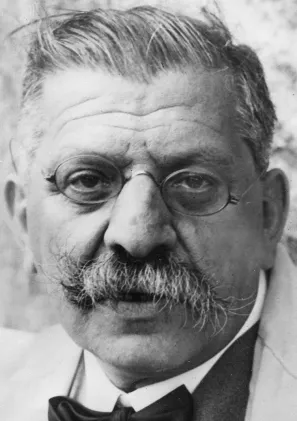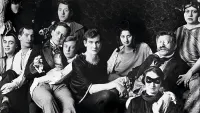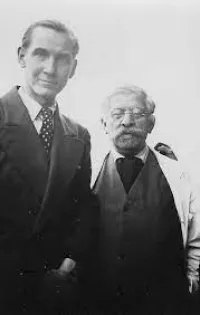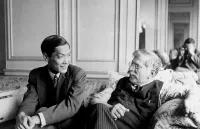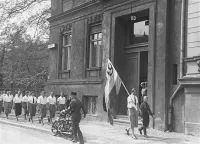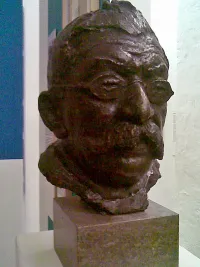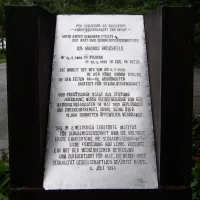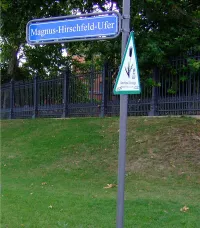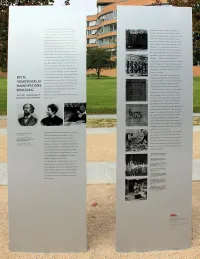Biography
1868 - 1935
“Soon the day will come when science will win victory over error, justice a victory over injustice, and human love a victory over human hatred and ignorance.”
– Magnus Hirschfeld
Groundbreaker sexologist Dr. Magnus Hirschfeld was born into an Ashkenazi Jewish family in Poland in 1868. After Hirschfeld received his medical degree, he traveled to Chicago to document the 1893 World’s Columbian Exposition for a German newspaper. While in Chicago, Hirschfeld discovered that the queer subculture of that city was like the one in Berlin and other cities. When Hirschfeld returned to Germany, he began seeing gay patients and found that several of them had scars from failed suicide attempts. One of these patients, a gay lieutenant, died by suicide in 1896 and this seminal and tragic event is what changed the course of Hirschfeld’s professional life. Hirschfeld moved his practice from Magdeburg to Berlin in 1896 where he published his first pamphlet under the pseudonym Th. Ramien that stated being queer is biological and innate and should not be criminalized. In 1897, Hirschfeld co-founded the Scientific-Humanitarian Committee with three other men. This was the world’s first-ever LGBTQ+ rights organization in the world. Their goal was to do research in defense of queer people and work to repeal the Paragraph 175 law that criminalized gay men in Germany, of which they were unsuccessful. Their motto was “Justice through science.” Hirschfeld also joined the feminist organization Bund für Mutterschutz and argued that queer rights and women’s rights were linked. They did stop the expansion of Paragraph 175 to include lesbians from becoming law. In 1919, Hirschfeld opened the Institut für Sexualwissenschaft (Institute for Sexual Science) in Berlin (where he and his longtime romantic partner, the German archivist and museum curator, Karl Giese lived on the second floor, however he never came out publicly) in the nascent days of the post-World War I more liberal Weimar Republic of Germany where he housed his immense archives and library on sexuality. The Institute also contained a Museum of Sex, provided educational services and medical consultations, and was the first recorded location where gender affirming surgeries took place, including Dora Richter. Hirschfeld had coined the term transvestite in 1910 to describe those who are now referred to as transgender people. One of the people inspired by Hirschfeld’s work was Chicagoan Henry Gerber who was stationed in Berlin during World War I and as a result he created the short-lived Society for Human Rights in Chicago in 1924. To further the work of the Institute, Hirschfeld traveled the world doing speaking engagements. While Hirschfeld was away in U.S., Adolf Hitler and his Nazi Party came to power in Germany and they immediately moved to destroy his Institute. On May 6, 1933, Nazi’s attacked and looted the Institute and four nights later his 20,000 books and journals, and 5,000 images, were destroyed in a book burning rally. Hirschfeld and his romantic partners Giese and Hong Kong medical student, sexologist, and LGBTQ activist Li Shiu Tong were forced to move to France to escape persecution. He died on May 14, 1935, his 67th birthday, in Nice, France and was cremated. His legacy lives on today in the work that other activists are doing to further LGBTQ+ equality.
1868 - 1935
“Soon the day will come when science will win victory over error, justice a victory over injustice, and human love a victory over human hatred and ignorance.”
– Magnus Hirschfeld
Groundbreaker sexologist Dr. Magnus Hirschfeld was born into an Ashkenazi Jewish family in Poland in 1868. After Hirschfeld received his medical degree, he traveled to Chicago to document the 1893 World’s Columbian Exposition for a German newspaper. While in Chicago, Hirschfeld discovered that the queer subculture of that city was like the one in Berlin and other cities. When Hirschfeld returned to Germany, he began seeing gay patients and found that several of them had scars from failed suicide attempts. One of these patients, a gay lieutenant, died by suicide in 1896 and this seminal and tragic event is what changed the course of Hirschfeld’s professional life. Hirschfeld moved his practice from Magdeburg to Berlin in 1896 where he published his first pamphlet under the pseudonym Th. Ramien that stated being queer is biological and innate and should not be criminalized. In 1897, Hirschfeld co-founded the Scientific-Humanitarian Committee with three other men. This was the world’s first-ever LGBTQ+ rights organization in the world. Their goal was to do research in defense of queer people and work to repeal the Paragraph 175 law that criminalized gay men in Germany, of which they were unsuccessful. Their motto was “Justice through science.” Hirschfeld also joined the feminist organization Bund für Mutterschutz and argued that queer rights and women’s rights were linked. They did stop the expansion of Paragraph 175 to include lesbians from becoming law. In 1919, Hirschfeld opened the Institut für Sexualwissenschaft (Institute for Sexual Science) in Berlin (where he and his longtime romantic partner, the German archivist and museum curator, Karl Giese lived on the second floor, however he never came out publicly) in the nascent days of the post-World War I more liberal Weimar Republic of Germany where he housed his immense archives and library on sexuality. The Institute also contained a Museum of Sex, provided educational services and medical consultations, and was the first recorded location where gender affirming surgeries took place, including Dora Richter. Hirschfeld had coined the term transvestite in 1910 to describe those who are now referred to as transgender people. One of the people inspired by Hirschfeld’s work was Chicagoan Henry Gerber who was stationed in Berlin during World War I and as a result he created the short-lived Society for Human Rights in Chicago in 1924. To further the work of the Institute, Hirschfeld traveled the world doing speaking engagements. While Hirschfeld was away in U.S., Adolf Hitler and his Nazi Party came to power in Germany and they immediately moved to destroy his Institute. On May 6, 1933, Nazi’s attacked and looted the Institute and four nights later his 20,000 books and journals, and 5,000 images, were destroyed in a book burning rally. Hirschfeld and his romantic partners Giese and Hong Kong medical student, sexologist, and LGBTQ activist Li Shiu Tong were forced to move to France to escape persecution. He died on May 14, 1935, his 67th birthday, in Nice, France and was cremated. His legacy lives on today in the work that other activists are doing to further LGBTQ+ equality.
Demography
Demography
Gender Male
Sexual Orientation Gay
Gender Identity Cisgender
Ethnicity Caucasian/White
Faith Construct Judaic
Nations Affiliated Germany
Era/Epoch Interwar Period (1918-1939) Progressive Era (1890-1920) Roaring Twenties (1920-1929)
Field(s) of Contribution
Academics
Advocacy & Activism
Author
Lecturer
Medicine
Science
Social Justice
Social Sciences
World History
Commemorations & Honors
Magnus Hirschfeld Society Established (1982)
German Society for Social-Scientific Sexuality Research Established the Magnus Hirschfeld Medal (1990)
Hirschfeld-Eddy Foundation Established (2007)
Promenade Between Moltke Bridge and the Chancellor's Garden Renamed Magnus-Hirschfeld-Ufer (2008)
Magnus Hirschfeld National Foundation Established (2011)
Demography
Gender Male
Sexual Orientation Gay
Gender Identity Cisgender
Ethnicity Caucasian/White
Faith Construct Judaic
Nations Affiliated Germany
Era/Epoch Interwar Period (1918-1939) Progressive Era (1890-1920) Roaring Twenties (1920-1929)
Field(s) of Contribution
Academics
Advocacy & Activism
Author
Lecturer
Medicine
Science
Social Justice
Social Sciences
World History
Commemorations & Honors
Magnus Hirschfeld Society Established (1982)
German Society for Social-Scientific Sexuality Research Established the Magnus Hirschfeld Medal (1990)
Hirschfeld-Eddy Foundation Established (2007)
Promenade Between Moltke Bridge and the Chancellor's Garden Renamed Magnus-Hirschfeld-Ufer (2008)
Magnus Hirschfeld National Foundation Established (2011)
Resources
Resources
Brook, Daniel. The Einstein of Sex: Dr. Magnus Hirschfeld, Visionary of Weimar Berlin. W. W. Norton & Company: New York, 2025.
Dose, Ralf. Magnus Hirschfeld: The Origins of the Gay Liberation Movement. Monthly Review Press: New York, 2014.
Lauritsen, John, and David Thorstad. The Early Homosexual Rights Movement (1864-1935). Rev. ed. Ojai, Calif.: Times Change Press, 1995.
Steakley, James D. The Homosexual Emancipation Movement in Germany. Salem, N. H.: Ayer, 1982.
Steakley, James D. The Writings of Dr. Magnus Hirschfeld. A Bibliography. Toronto: Canadian Gay Archives Publication
Series, No. 11 / Schriftenreihe der Magnus-Hirschfeld-Gesellschaft, Nr. 2, 1985.
Wolff, Charlotte. Magnus Hirschfeld: A Portrait of a Pioneer in Sexology. London: Quartet Books, 1986.
https://www.britannica.com/biography/Magnus-Hirschfeld
https://encyclopedia.ushmm.org/content/en/article/magnus-hirschfeld-2
https://www.scientificamerican.com/article/the-forgotten-history-of-the-worlds-first-trans-clinic/
https://blog.sciencemuseum.org.uk/magnus-hirschfeld-and-the-institute-for-sexual-science/
https://magnus-hirschfeld.de/ausstellungen/institute/
https://www.teenvogue.com/story/lgbtq-institute-in-germany-was-burned-down-by-nazis
Resources
Brook, Daniel. The Einstein of Sex: Dr. Magnus Hirschfeld, Visionary of Weimar Berlin. W. W. Norton & Company: New York, 2025.
Dose, Ralf. Magnus Hirschfeld: The Origins of the Gay Liberation Movement. Monthly Review Press: New York, 2014.
Lauritsen, John, and David Thorstad. The Early Homosexual Rights Movement (1864-1935). Rev. ed. Ojai, Calif.: Times Change Press, 1995.
Steakley, James D. The Homosexual Emancipation Movement in Germany. Salem, N. H.: Ayer, 1982.
Steakley, James D. The Writings of Dr. Magnus Hirschfeld. A Bibliography. Toronto: Canadian Gay Archives Publication
Series, No. 11 / Schriftenreihe der Magnus-Hirschfeld-Gesellschaft, Nr. 2, 1985.
Wolff, Charlotte. Magnus Hirschfeld: A Portrait of a Pioneer in Sexology. London: Quartet Books, 1986.
https://www.britannica.com/biography/Magnus-Hirschfeld
https://encyclopedia.ushmm.org/content/en/article/magnus-hirschfeld-2
https://www.scientificamerican.com/article/the-forgotten-history-of-the-worlds-first-trans-clinic/
https://blog.sciencemuseum.org.uk/magnus-hirschfeld-and-the-institute-for-sexual-science/
https://magnus-hirschfeld.de/ausstellungen/institute/
https://www.teenvogue.com/story/lgbtq-institute-in-germany-was-burned-down-by-nazis
